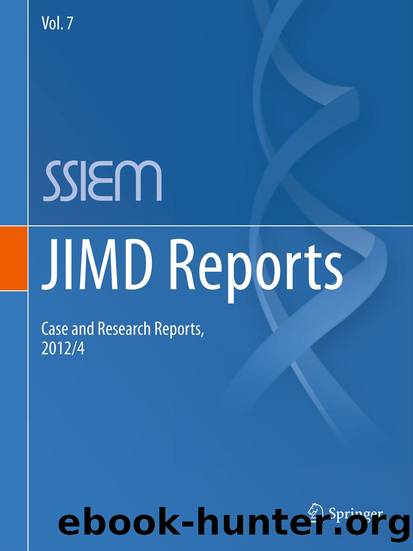JIMD Reports - Case and Research Reports, 20124 by Garry Brown Eva Morava Verena Peters K Michael Gibson & Johannes Zschocke

Author:Garry Brown, Eva Morava, Verena Peters, K Michael Gibson & Johannes Zschocke
Language: eng
Format: epub
Publisher: Springer Berlin Heidelberg, Berlin, Heidelberg
Discussion
This case report describes the occurrence of autism in a child with propionic acidemia (PA). While a chance occurrence of the two syndromes cannot be ruled out, it is possible that PA may have played a role in the emergence of autistic features in this patient because acute and chronic abnormalities of brain function are well-documented in PA (de Baulny et al. 2005; Schreiber et al. 2012). Alternatively, it is possible that the patient was already vulnerable to autism due to some other reason and that PA acted only as a trigger, a view consistent with the so-called two-hit hypothesis of the disorder (Ghaziuddin 2000). Noteworthy, urea cycle disorders, characterized by hyperammonemia, may present with confusion, bizarre behavior, and autistic-like symptoms (Gorker and Tuzun 2005; Sedel et al. 2007). It is possible that the recurrent bouts of hyperammonemia played a role in the development of the autistic symptoms in our patient. In the consensus conference about diagnosis and management of PA hosted in Washington, D.C. in January 2011, there was no reported association among the neurological sequalae of the disease between PA and autism (Schreiber et al. 2012; Sutton et al. 2012). This could be related to the fact that children with severe-profound intellectual disability may have impaired social interactions and the diagnosis of ASD might be challenging.
Recent reports have suggested that propionic acid (PPA) may be used to induce an animal model of autism (MacFabe et al. 2007, 2008). PPA, a short-chain fatty acid, is an intermediate of cellular metabolic pathways. As a weak acid, PPA exists in both aqueous and lipid soluble forms; it crosses the blood-brain barrier both passively and actively through specific monocarboxylate transporters (Thomas et al. 2010). Intracerebroventricular injection of PPA in adult rats produced behavioral, biochemical, electrophysiological, and neuropathological effects similar to those observed in autism (MacFabe et al. 2007, 2008; Shultz et al. 2009, 2008). Following intracerebroventricular infusions of PPA, there was an evidence of a relationship between changes in brain lipid profiles and the occurrence of autistic behaviors (Thomas et al. 2010). Collectively, the effects of PPA in rats included reversible repetitive dystonic behaviors, hyperactivity, turning behavior, retropulsion, caudate spiking, and the progressive development of limbic kindled seizures (MacFabe et al. 2007). Similarly, systemic administration of PPA has been shown to cause social deficits, anxiety-like and hypoactivity behavior in juvenile rats (Shams et al. 2009).
There is a strong correlation of gastrointestinal symptoms with autism severity in children with ASDs (Adams et al. 2011). Within the group of children with autism and gastrointestinal disturbances, unique impairments of carbohydrate digestion and transport, and mucosal dysbiosis were found (Williams et al. 2011). This underlies the hypothesis that there exists a relationship between increased production of enteric short chain fatty acids, including PPA from the altered carbohydrate fermentation and the long-term development of ASD-related behavioral changes (Ossenkopp et al. 2012).
Our patient’s symptoms could not be explained on the basis of global intellectual disability alone. Compared to other intellectually disabled children, her symptoms had a unique and
Download
This site does not store any files on its server. We only index and link to content provided by other sites. Please contact the content providers to delete copyright contents if any and email us, we'll remove relevant links or contents immediately.
Nutrition for Sport, Exercise, and Health by Spano Marie & Kruskall Laura & Thomas D. Travis(3715)
Nutrition for Sport, Exercise, and Health by Marie Spano & Laura Kruskall & D. Travis Thomas(3683)
The Sprouting Book by Ann Wigmore(3543)
Flavor Flours by Alice Medrich(2814)
Superfood Smoothie Bowls: Delicious, Satisfying, Protein-Packed Blends that Boost Energy and Burn Fat by Chace Daniella(2387)
Memory Rescue by Daniel G. Amen(2376)
Dirty Genes by Ben Lynch(2272)
The Bad Food Bible by Aaron Carroll(2235)
Genius Foods by Max Lugavere(2179)
The Poisoner's Handbook by Deborah Blum(2091)
Good Calories, Bad Calories by Gary Taubes(2072)
The Main Street Vegan Academy Cookbook by Victoria Moran(2033)
The I Quit Sugar Cookbook by Sarah Wilson(2001)
Core Performance Essentials by Mark Verstegen(1981)
Memory Rescue: Supercharge Your Brain, Reverse Memory Loss, and Remember What Matters Most by Amen Dr. Daniel G(1947)
Big Girls Do It Stronger by Jasinda Wilder(1899)
Android App Development by Franceschi Hervé J.;(1818)
Sugar Crush by Dr. Richard Jacoby(1769)
Dr. Colbert's Keto Zone Diet by Don Colbert(1628)
